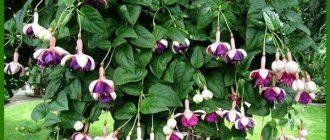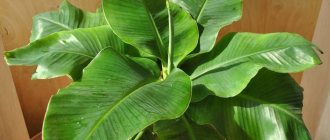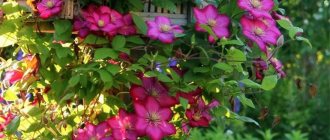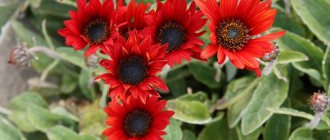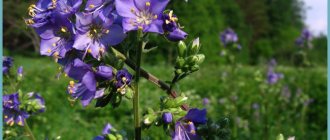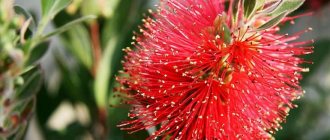Simultaneously with the great geographical discoveries, a fashion arose for collecting plants brought from tropical forests. The first winter gardens were opened in the 13th century in England. In their humid and warm microclimate, orchids, citrus fruits and ferns, including a variety of maidenhairs, thrived. The fashion for winter gardens became so popular that almost every house in England had, if not winter gardens, then florariums with a collection of ferns from local forests.
Adiantums are plants native to East Asia and the mountains of South America. In the Andes, along the banks of rivers and on the slopes under the jets of a waterfall, the greatest species diversity is found. The name of this plant can be translated from Greek as “non-wetting”. Indeed, despite living under the canopy of humid forests, the leaves of the plant have the ability to repel droplets of moisture and remain dry.
The plant received another name “Venus Hair” for its thin, shiny, black petioles and openwork foliage, reminiscent of a drop of hair. According to one legend, the goddess of love Venus dropped a strand of hair, and an adiantum grew in this place. There is also an ancient Slavic legend associated with ferns. Once a year, on the night of Ivan Kupala, the fern blooms. Anyone who finds a fern flower in the forest will have secret knowledge. Of course, no one managed to find him.
Ferns are also used in landscape design. Shade-tolerant and moisture-loving, they thrive under the shade of trees and along the banks of artificial reservoirs. They retain their decorative effect until frost, changing color from green to crimson.
Description of the plant
The maidenhair fern is a beautiful representative of the Pteris family, numbering about 200 species.
East Asia is considered the birthplace of adiantums; from there the plant spread throughout Western Europe, the Mediterranean, Africa and the central regions of South America. On the territory of Russia, some species are found in the mountains of Crimea and Transcaucasia. Adiantum is a perennial herbaceous plant up to 60 cm high. The rhizome is curved, pubescent, with thin roots. On black petioles there is a dissected, glaucous or green leaf blade. Adiantum leaves are arranged in alternate or opposite order. The leaf shape is fan-shaped or trapezoidal, the venation is reticulate. Like all ferns, the maidenhair flower does not have inflorescences. On the reverse side of the leaf there are round or oval sori with sporangia.
Venus hair is a beautiful house plant that has gained its popularity precisely thanks to its very delicate and delicate foliage.
Watering
You need to know how to water a flower. The substrate must not be allowed to dry out, otherwise the fronds will begin to dry out. But under no circumstances should you overwater, otherwise the roots will rot.
The most convenient way is to immerse the flowerpot with your green friend in a bowl of water. Wait until the top layer of soil shines and put it in the sink to drain off the excess. After this, return to its normal place.
In winter, the intervals between waterings need to be doubled, but such baths should be carried out from time to time.
Types and varieties
The small family includes 200 species of adiantums. There are varieties that can live only indoors, such as the adiantum Venus hair, and varieties suitable for growing in gardens in central Russia, including the adiantum Stopovidny.
Adiantum stopovidny
Adiantum stopovidny
Adiantum Stopovidny can be considered the most frost-resistant species. It can withstand frosts down to -35 degrees. It is an elegant plant up to 60 cm high. Leaf plates, strongly dissected and pinnate, are located horizontally on black petioles. The color of the leaves is light green. The rhizome is thin and short. Prefers shady places in the garden with soil rich in humus, slightly acidic or acidic loose soils. The main requirement for cultivation is moderate humidity; the plant does not tolerate drought. Its homeland is the forests of North America, in Russia it is found in the Amur region, and Primorye, the Kuril Islands and the south of Sakhalin. In the middle zone, it remains decorative from May to November, until the onset of frost.
Breeders have developed several successful varieties: Compactum (height 35 cm), Imbricatum (height 15 cm), Aleuticum (height 12 cm, suitable for home cultivation), Japonicum (height 45 cm, young shoots of copper-pink color).
Adiantum Venus hair
Adiantum Venus hair
Adiantum Venus hair is a low plant found in Britain, the Caucasus mountains, Crimea and Asia. The plant barely reaches 30 cm in height. It is distinguished by thin, shiny, black petioles and fan-shaped leaf plates of light green color. It is often grown as a houseplant. Prefers slightly acidic, well-moistened soil. The air in the room should also be about 60-70% humidity. Does not suffer from lack of light even in winter. Possible to grow on northern windows. To maintain humidity, plants are placed in terrariums or placed on a tray with pebbles filled with water. Venus hair loves fresh air, rich in oxygen, and does not tolerate drafts. It will grow poorly in the kitchen and in a room where people smoke.
Adiantum Fragrance
Adiantum Fragrance
Adiantum Fragrans - common in the Andes and the mountains of South Asia. In cultivation it is grown as a houseplant. The height reaches 50 cm. It grows quickly and forms dense bushes. The leaf blade (3 cm) on petioles (10-15 cm) is oval, light green in color.
Adiantum Venustum
Adiantum Venustum
A miniature representative of the Pteris family, it grows up to 20 cm. The homeland of Venustum (Venustum) or Charming Adiantum is Nepal and Kashmir. The dark purple petioles bear light green plates with a slightly pointed tip. Can be grown in gardens in central Russia. After frost, the foliage turns brown.
Adiantum Reniform
Adiantum Reniform
Adiantum Reniforme came to our windowsills from the Canary Islands. The plant is miniature. Depending on the subspecies, the size of the plant ranges from 5 to 25 cm. Solid horseshoe-shaped leaves are located on thin black petioles.
Adiantum Chilean
Adiantum Chilean
A compact species that lives on mountain slopes. Its leaves have rounded teeth and are pressed tightly against each other, overlapping the leaf blades. Adiantum Chilense can tolerate drought, but not for long.
Adiantum Ethiopian
Adiantum Ethiopian
Ethiopian maidenhair (Adiantum Aethiopicum) is common not only in Africa, but also in New Zealand and Australia. A characteristic feature is a change in the color of the petioles. The lower part is black, closer to the leaf it is purple. The leaf blades are wedge-shaped with a rounded edge, highly branched.
Adiantum Caudate
Adiantum Caudate
Adiantum Caudatum is a large representative of the family. On purple petioles, reaching a length of 60 cm, there are light green leaves. Each leaf ends with a sucker. The plant is grown only as a houseplant and is very demanding of moisture. If the earth clod dries out, it may die. At home it is grown as an ampelous plant.
Adiantum Wedge-leaved variety "Lady Geneva"
The plant is about 35 cm high. The petioles are black, the shape and arrangement of the leaves are very similar to Venus's hair, only more crowded. One leaf plate, like the scales of a fish, overlaps the other.
Adiantum wedge-shaped variegated
Adiantum wedge-shaped variegated
It grows naturally in the south of Brazil. Large species, up to one meter in height. Petioles are dark purple in color. The leaf blade is obovate, green in color, with white stripes. On the reverse side of the leaf are sori in the shape of a horseshoe.
Adiantum Largeleaf
Adiantum Largeleaf
Adiantum Macrophyllum is a large representative. The leaf can grow from 30 to 50 cm. Young shoots are colored brown-red and become green over time. In South America it grows along roads and drainage ditches.
Adiantum Micropinnulum
Delicate species, very sensitive to lime and fluorine content in water. Doesn't like moisture getting on the leaves. The height of the adiantum is about 15 cm. The bush can reach a diameter of up to 30 cm. The leaf blades are light green, on shiny black petioles.
Adiantum Gentle
Adiantum Gentle
One of the names of this species is Adiantum pink. Includes varieties such as Farleyens (adiantum with strongly curled leaves) and Scutum Roseum (young shoots are light pink). The rhizome is creeping and short. The leaf blade is wedge-shaped, strongly dissected, up to 70 cm long, up to 50 cm wide. Black petioles up to 30 cm. Tender adiantum is used as a houseplant.
Small-leaved species of adiantum Ruddy
Adiantum raddianum is an epiphytic plant of South America. The petiole is black, very thin, up to 20-25 cm long. The leaves are triangular and triply pinnate. Leaf length up to 45 cm, width up to 25 cm. Each small leaf has the shape of a fan (up to 1 cm). On the reverse side of the leaf, in a recess, there are semicircular sporangia. Grows well at home.
Adiantum finely pubescent or finely hairy
Adiantum finely pubescent or finely hairy
Adiantum Finely pubescent has another name - finely haired or bristle-haired (Adiantum Hispidulum). It got its name due to the hairy covering of the leaves and petioles. A perennial herbaceous plant suitable for home cultivation. It grows wild on the island of Madagascar, India, Australia, Africa and New Zealand. The plant is resistant to cold and does not require soil; it can grow on mountain ledges. The root system is represented by a thin rhizome. The leaves are 1.5-2 cm long, diamond-shaped. The petiole is brown, covered with small bristles, and grows up to 35 cm. It feels great as a houseplant.
The subtleties of growing Venus hair
A beautiful plant that is fully acclimatized at home does not require special care. It is important to follow a few simple growing rules:
- High humidity - you can place the pot in a container with wet pebbles or in an external container filled with wet peat;
- Lighting of medium intensity - does not tolerate direct sunlight (burns remain). Place on the northern window sill and deep into the room. Can be grown in a greenhouse under shelving;
- The optimal temperature is at least +10 degrees. If it drops below the mark, it dies. Adiantum adapts perfectly to both high and low temperatures. Suitable for growing in a summer garden, requires wintering at home. If the temperature is above +20, an increase in air humidity is required;
- Regular watering - the earthen ball should be constantly moist. Avoid overwatering - the roots will rot. In summer, use rainwater; in winter, let it sit for at least a day. In hot weather, watering is increased to twice a week, in cold weather it is reduced to once. Drying out threatens death and yellowing of the leaves;
- Fertilizing with liquid fertilizers - no more than once every 2 weeks and only during the growing season (summer);
- Clean the leaves from dirt - without using cleaning products (soap and others);
- Adiantum does not tolerate cigarette smoke, combustion products and the smell of food.
For planting and replanting, use the nutrient composition of the soil:
- Special peat compositions;
- A mixture of turf soil, fine sand, fibrous peat with basic fertilizer.
Maidenhairs are not as attractive when grown in large pots. For planting and replanting, use containers that already have the root system. The pots should not be enough.
Adiantum transplants
The plant can be replanted from late spring to early July. Transplantation is needed for those adiantums that have grown out of the pot and seem too large for the container. Before the procedure, the plant must be watered abundantly so that the dried soil does not injure the young roots.
For replanting, a pot one size larger than the previous one is suitable. Provide a strong drainage layer and a suitable soil composition (with plenty of peat). Next follow the instructions:
- Hold the pot with one hand. Tilt it and use your other hand to pull the stems. If the adiantum does not give in, the soil is poorly moistened;
- Lightly tap the bottom of the pot;
- When you remove the plant, carefully remove the old layer of soil using a pencil and a wooden stick. Try not to injure the rhizome;
- Place the adiantum in the center of the new pot and renew the soil.
The soil should not be pressed too hard. All roots must be hidden by a layer of soil. After transplantation, the adiantum should not be watered for 2 days. Lighting should be minimal at this time - place the pot in the shade.
Home care
Like any fern, care for maidenhair comes down to maintaining humidity in the room and pot. Of all the types, Venus hair adiantum is the least demanding to care for. It is more often found as an indoor plant than other ferns. The plant is very sensitive, gets used to one place and does not like to be moved.
Lighting
The shade-tolerant plant is suitable for rooms with northern and eastern windows. It does not require additional lighting even in winter, but on sunny summer days it is better to shade the delicate leaves.
Temperature
Despite its tropical origin, Venus Hair prefers moderate temperatures indoors, +22°C in summer and not lower than +15°C in winter.
Air humidity
Ideal air humidity is about 60-70 percent. Unfortunately, it is difficult to maintain such humidity in a room, especially with central heating. Dwarf varieties are recommended to be grown in terrariums, and large species can be placed on a tray with pebbles. To do this, pour pebbles or expanded clay into a tray, place a pot on it, and fill it with water to the level of the pot so that the roots of the plant do not come into contact with water. A more compact way is to place the pot in a flowerpot with sphagnum moss or wet peat. You can place the plant in the bathroom, provided there is a window there. Place the pot next to a constant source of moisture, an aquarium or a humidifier. Spraying is not the best method, as its effect disappears after the drops dry.
Watering
Despite the love of ferns for moisture, waterlogging leads to rotting of the roots. If you allow the earthen clod to dry out, the leaves will turn yellow, die, and cannot be restored. The optimal method of watering is to immerse the pot in a container with warm, settled water. After the soil is saturated, remove the pot and allow it to drain. To avoid root rotting during transplantation, add 1-2 cm of drainage. It will increase the supply of oxygen to the roots and help avoid water stagnation. The time of year also affects the intensity of watering. In summer, it is better to water twice a week; in winter, once will be enough. Water for irrigation must also be selected carefully. Venus hair is sensitive to chlorine and water hardness; it is advisable to first filter and settle it.
Top dressing
Adiantums are very sensitive to fertilizers. High concentrations may burn the plant's tender roots or leaves during spraying. Fertilizing should be done from May to October during the active growing season. Once or twice a month is enough. It is better to choose organic fertilizers, with a minimum content of minerals.
The soil
The soil should be slightly acidic, loose and nutritious. The ideal ratio is 2:1 from peat and leaf soil. Looseness can be added with perlite or sand. You can also add sphagnum moss and charcoal.
Possible difficulties
In indoor conditions, maidenhairs often dry out. This manifests itself in yellowing and dying leaves. This can be avoided by adjusting watering and air humidity. The absence of turgor in the leaves indicates waterlogging or insufficient watering. The reason for the pale color of the leaves can be very bright lighting; the plant should be hidden from direct sunlight, especially in summer.
In winter, the plant may freeze or suffer from drafts, this manifests itself in curling of the leaves. It is necessary to reduce watering and move the plant to a place inaccessible to drafts.
From the terrarium to the apartment: how to care for adiantum
The task of the gardener who grows adiantum is to create an environment familiar to this fern at home. Once upon a time, the delicate Venus hair was recommended to be planted only in terrariums and greenhouses. Now it is successfully raised in ordinary homes. You just need to follow simple rules for caring for adiantum.
Watering and fertilizing mode
The first rule of watering for adiantum is regularity and moderation. This fern has a negative attitude towards both drying out the soil and waterlogging it. Therefore, you should water the adiantum a little, but often. In spring and summer up to 3 times a week, in autumn less often, and in winter once every 7-10 days is enough. The main thing is that the top layer of soil should dry out between waterings.
Adiantum does not tolerate chlorinated water
Use settled, or better filtered, water for irrigation. Adiantum does not tolerate chlorinated water well. Some gardeners advise watering it with water drained from the aquarium.
During active growth, in spring and summer, the adiantum will be grateful for feeding. Food is added once every 2-3 weeks. Organic complexes are suitable for ferns or plants with decorative leaves. Reduce the dosage recommended by the manufacturer by half. Adiantum will not like mineral fertilizers. From late autumn to spring, they stop feeding the plant.
Unseen flowers
There are many beliefs about fern blossoms. This plant, living in the thicket, where it is damp and scary, caused fear, and mysterious powers were attributed to it. Our ancestors could not understand how Venus hair reproduces. Therefore, legends about the wonderful fern flower were born.
The fern blooms magically, as our ancestors believed. On the eve of the summer solstice (the holiday of Ivan Kupala), a fiery flower appears, such that one cannot look at it. It blooms for a few seconds. Then an invisible force tears off the fiery color. If a person breaks it first, he will gain power over everything.
Science has debunked the mysteries of ferns. Adiantum, like its relatives, never blooms. Instead, nature has provided another mechanism of reproduction - spores. Adriatum spores form from spring to autumn. They ripen at the tips or along the edges of leaflets in the sori. As the spores mature, they become brownish in color. They are very small, like dust. You can collect spores by cutting off a leaf and placing it on white paper.
Diseases and pests
Adiantums are susceptible to diseases and pests. Viral diseases manifest themselves as reddening of the leaves around the edges, then entirely. The disease is transmitted by certain types of insects. The plant will have to be destroyed by treating other flowers against insect vectors. The cause of leaves curling and dying can be the appearance of aphids, spider mites, thrips and scale insects. Insects can be seen with the naked eye; along with them, a sticky coating and cobwebs appear on the leaves. To combat them, insecticides (Fitoverm, Fufa-Nova, Iskra) are used in accordance with the instructions. Scale insects can be removed mechanically - with a cotton pad treated with soapy water. The procedure must be repeated every week.
Transplantation and propagation
Maidenhair plant is perfect for growing in open ground with a mild climate. It independently reproduces by spores and with the help of creeping rhizomes. Indoor species of young ferns are replanted every spring, and adult plants only in cases where the root system fills the entire pot. Often this procedure is combined with dividing the plant.
Transplantation and transplantation features
Ferns are transplanted in the spring, before active growth. For indoor species, it is advisable to choose a wide and shallow pot, since their root system is superficial. Place drainage at the bottom of the pot, which can also be replaced with pebbles or broken bricks. You can buy ready-made soil or make it yourself. The composition of the soil may include: leaf or turf soil, pine bark, peat, coconut fibers, coarse sand or perlite, humus or vermicompost. Sphagnum moss and charcoal are added to maintain moisture to prevent rot. The resulting mixture must be sterilized in the oven or poured with boiling water.
Adiantum propagation
Adiantum can be propagated by dividing the bush or by spores. Reproduction by dividing the rhizome will help rejuvenate an overgrown adult plant that has lost its decorative effect. The procedure will allow you to quickly obtain ready-made plants. Due to the fact that the plants are quite delicate, there is a high risk that the flower will not take root. In spring, adult ferns are removed from the pot, the rhizome is cleaned and dry old roots are removed. Using a sharp and sterile knife, the rhizome is divided into parts. Each root segment must have a bud with leaves. The cut site must be treated with activated carbon or another antiseptic. The resulting young plants are planted in separate containers with light and sterile soil. For better rooting, cuttings can be immersed in Kornevin solution before planting. The finished seedlings are placed in a warm, humid room or greenhouse, shaded from direct sunlight.
Growing young plants with spores requires more time and preparation. The optimal temperature is +22 degrees, constant high humidity is required. Mature spores collected from a large leaf are distributed into sterile soil evenly over the surface. Lightly sprinkled with soil, moisten the spores and cover them with glass or film. The room should have a stable temperature of +22...+25 degrees and minimal lighting. It may take 3 months before the first shoots appear. After germination, the film is removed and the seedlings are transferred to a lighted room. The seedlings are thinned out, leaving large and healthy specimens. For good development, the distance between them should be at least 3 cm. After just a month, the young plants are ready for planting in separate pots; you can also plant several plants in one pot.
How does adiantum reproduce?
Adiantum is propagated by dividing the rhizome during transplantation and by spores. Each method has positive and negative sides.
Root division
By dividing the root, only mature, or preferably old, ferns that have already begun to lose their decorative properties are propagated. Dividing the root is not such a harmless procedure. If the operation is unsuccessful you may lose the mother plant. And the survival rate of separated parts is not always high. The root of the adiantum is very sensitive, as is the whole plant.
- In spring, remove an adult adiantum bush from the pot.
- Clean the root system from the substrate.
- Using a sharpened sterile knife, cut the rhizome into pieces so that at least one leaf remains on each.
- Plant the parts in separate containers filled with light soil, sterilize it first.
- Spray the seedlings and moisten the soil.
- Place new plants in a shady and warm place.
- Apply foliar feeding through spraying.
- Adiantum seedlings develop slowly. Like adult ferns, they need high humidity, diffused light and warmth.
Young adiantums have taken root in new pots
Video: planting adiantum seedlings at home (master class)
Use in folk medicine
Adiantum Venus hairs began to be used in medicine earlier than other ferns. The ancient Romans, noticing its resemblance to hair, recommended it for the treatment of baldness. In the Middle Ages in Armenia they treated jaundice, urolithiasis and chronic fever. Currently, in the Caucasus and Western Europe, the tradition of rinsing hair with adiantum infusion to give it shine has been preserved. In China, where traditional medicine is very popular, a decoction of the leaves is used to treat alcoholism and tobacco addiction.
There is a belief that ferns have the ability to protect the house from evil spirits, as well as calm their owners and eliminate conflicts.
Beneficial features
Maidenhairs, especially Venus hair, have antipyretic, antiparasitic, soothing and anti-inflammatory properties. The leaves contain flavonoids, triterpenoids, lipids, steroids, phenolcarboxylic acids and essential oils.

